By Sören Stamer
 Turnarounds from the brink of death or irrelevance are in high demand these days. AOL, MySpace, Yahoo!, Nokia, and RIM have all had their moment in the sun as the celebrated leaders of hot markets. All of them lost it, and many more have done so as well. Some fell out of the sky with sales numbers plummeting 40% and more per year. Others dragged it out and, instead, slowly faded away. One of them was Apple in 1997. Now the most valuable company in the world, it had lost nearly 50% of its revenue and came pretty close to bankruptcy. But then they came back with a vengeance. In fact, they now seem nearly unstoppable, disrupting more and more markets. They are the only technology company that has been able to define not just one, but two computing eras: first, with the introduction of the Macintosh, which defined the PC era; and then the debut of the iPhone, which has ushered in the smartphone era. That leaves Marissa and us with two compelling questions: How did Steve Jobs do it? Can it be done again?
Turnarounds from the brink of death or irrelevance are in high demand these days. AOL, MySpace, Yahoo!, Nokia, and RIM have all had their moment in the sun as the celebrated leaders of hot markets. All of them lost it, and many more have done so as well. Some fell out of the sky with sales numbers plummeting 40% and more per year. Others dragged it out and, instead, slowly faded away. One of them was Apple in 1997. Now the most valuable company in the world, it had lost nearly 50% of its revenue and came pretty close to bankruptcy. But then they came back with a vengeance. In fact, they now seem nearly unstoppable, disrupting more and more markets. They are the only technology company that has been able to define not just one, but two computing eras: first, with the introduction of the Macintosh, which defined the PC era; and then the debut of the iPhone, which has ushered in the smartphone era. That leaves Marissa and us with two compelling questions: How did Steve Jobs do it? Can it be done again?
How did Steve Jobs turn around Apple?
Jobs had to steer Apple away from its main market in order to return and disrupt it. Apple didn’t have a chance to win against the Wintel monopoly by building better PCs. They were stuck in a niche and had to build momentum outside the mature personal computer market in order to have a real chance at disrupting it. In that regard, it was a boon for Apple that people thought the company had lost their way when they launched the iPod instead of a new Mac, MacBook or Newton.
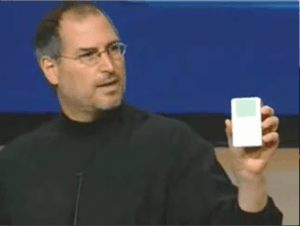
People in the industry dismissed it and nobody tried to stop Apple from owning the online music business until it was too late. When Microsoft finally realized the iPod threat and came out with their own music device, the Zune, they failed to make even the smallest dent in Apple’s market dominance. By that point, “Apple 2.0”—with Jobs’ singular focus on design and innovation—was unstoppable. The iPod led to the iPhone, the iPhone led to the iPad, and both led to the MacBook Air and MacBook Pro with Retina Display, all of them taking away market- and mind-share from Microsoft, not to mention other PC and device competitors.
Not that long ago, Microsoft has acknowledged their strategic misery by launching their own tablet computer, the Microsoft Surface. They have decided to compete with their existing partners in order to survive in an Apple world, a clear indication that Microsoft is scared by Apple’s success.
With hindsight, we can easily see the cascade of waves that Steve Jobs surfed with Apple, with increasing size and momentum. To take away valuable turnaround lessons for other companies, it is instructive to segment the 6 different phases of Apple’s turnaround.
Phase 1: Stop the bleeding
A lot has been written about the immediate actions Steve Jobs took after joining Apple for the second time to stop the bleeding and instill some trust in Apple’s survival. He was selling factories, slaying 11 of 15 product categories, cutting (!) the R&D budget by 50%, and laying off a thousands of workers. He also broke a taboo and forged a partnership with archenemy Microsoft. Some might vividly remember the disturbing image of Bill Gates’ gigantic face appearing above Steve like big brother.
The severe cost cutting and Microsoft’s investment in Apple where mission-critical in giving him enough runway to bring a few new products to the market.
It takes a determined (or a truly desperate) mind to do this kind of cost cutting. And that is the reason why many companies fail before they even start. Delusion and ignorance are so much easier to implement (until you hit the ground). While accepting the hard truth about your failing company is difficult, it is the only chance you have. Steve Jobs did exactly that when he concluded that Apple can’t afford to continue fighting with Microsoft anymore.
Steve Jobs did something else that kind of stopped the bleeding. He launched one of the best ads ever made.
Think Different told everyone believing in Apple why it was worthwhile to keep Apple alive and not follow Michael Dell’s advice. With this ad, Steve Jobs refreshed the meaning that every existing and future Apple product comes bundled with. It will turn out to be the hardest thing to copy for all competitors.
Phase 2: Focus your core business
But cost-cutting and image ads only carry you so far. Apple had to increase their top line in order to survive.
The first new product Apple released after Steve Jobs’ coming home was the original iMac. It was surprising what a difference a little color makes. Adding color to this cute little desktop computer became an instant success. It was also a nice showcase of everything Apple: beautiful to look at, simple to use and innovative. So far, everyone thought computers had to be beige or black and sell through their technical specs. Not anymore.
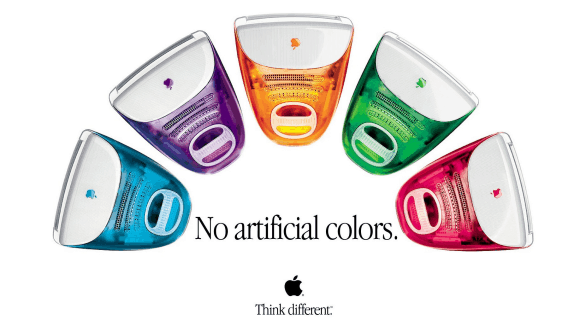
The iMac success helped to keep Apple alive and made it shine again for the first time. However, it didn’t change the underlying dynamic of the PC market. Microsoft owned it and Apple was still only surviving in a small niche.
Phase 3: Figure out where the puck will be going
The strategic genius of Steve Jobs is visible the most in what came next. He must have realized at this point that Apple cannot win against Microsoft and Intel the old fashioned way by building better, more reliable, easier to use and more beautiful but conventional computers. Those things just didn’t matter in a world where Microsoft Windows, Word and Excel were the standards in nearly every industry and nearly every user’s mind. The market for personal computers was in a pretty mature state at this point in time. There was no chance at all for Apple to be ten times better than the whole Windows ecosystem and get people and companies to switch. In order to win, Apple had to change the rules of the game. Further frontal attacks against Wintel were simply futile.
I don’t have any internal knowledge of Apple considerations at that time, but I am pretty sure that Steve Jobs was pretty aware that Moore’s Law will give us powerful pocket-size computers in a not too distant future. “A computer in every pocket” was the logical conclusion. That sounds awfully lot like “A computer on every desktop”, Bill Gates’ big and tremendously successful vision for Microsoft in the 80th. And Microsoft’s board might wonder why they missed this obvious next step after Microsoft succeeded with their initial vision in the 90th. Fortunately for Apple, Microsoft didn’t think ahead. Instead, they waisted a lot of time milking their customers and trying to be like Google.
Ironically, Apple made “a computer in every pocket” happen. They didn’t call it a computer though.
Phase 4: Take the first step
The first step to take advantage of the inevitable mobile revolution was not to launch a handheld computer. Apple tried that before with the Apple Newton and failed. Too complex, too expensive and too much of a niche market.
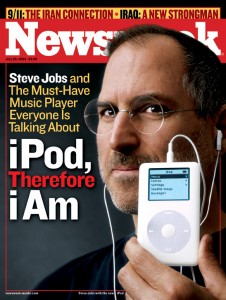
So Apple did something surprising. They launched the original iPod — no new computer, no better laptop and no new Newton, just a portable music player. Some Apple fan boys were up in arms: “iPoop…iCry. I was hoping for something more”. Nonetheless, the iPod became a hugh success and laid the groundwork for Apple to leapfrog Microsoft a few years later.
The beauty of the initial iPod for Apple was its simplicity. It just had one feature, playing your music on the go. Other than the Apple Newton, it addressed a clear need (all your music on the go) with a huge market potential (who doesn’t like music) and a lack of simple solutions (Sony, anybody?). At the same time, it was the first mobile computer product that reached mass adoption around the world and defined a new market. The enormous sales numbers enabled Apple to build a supply chain that is unmatched by their competitors.
It is difficult to overstate the strategic value of the iPod for Apple. The iPod sold like hot cakes and made a lot of money for Apple. It became a cultural icon and dramatically increased the number of people who own at least one Apple device. And because it worked well with Windows, iTunes for Windows became the first piece of Apple software that many people laid their hands on. Suddenly, many experienced the joy of using Apple products and decided to buy Apple computers instead of Windows PCs, creating Apple’s famous halo effect.
Steve Jobs made another strategic move to get as many people as possible experience an Apple product or service for the first time. He launched Apple’s own stores. What was dismissed by many experts (as usual, one might say), turned over time into one of the most successful retail business on Earth.
The iPod experience was strategic in two more ways, 1) iPods were bought by consumers, not enterprises and 2) iPods smoothly bundled a piece of hardware with software and services. Both aspects are disrupting multiple industries these days. The consumerization of IT broke Microsofts’ and RIM’s influence on IT departments and is here to stay. And the integration of hardware, software and services is the new black. Given Apple’s success, it is no big surprise that Google, Microsoft and Amazon changed course and copy Apple’s bundled approach for seamless integrated hardware, software and services.
Phase 5: Build momentum
The momentum of Apple’s iPod business soon overshadowed their old core business. After launching and developing multiple iPod variations, it was time to catch the next big wave. The rise of smartphones threatened to make iPods redundant some day. Smartphones had been around for a while but they still kind of sucked. They offered only a crippled Internet experience, where complicated to use and lacked a smooth music experience that could compete with the beloved iPod. In 2006, everyone and their grandmother was expecting Apple to build a so-called “iPhone”. Couldn’t Apple build a mobile phone that works elegantly like an iPod and excels as a phone and mobile computer? Well, they could.
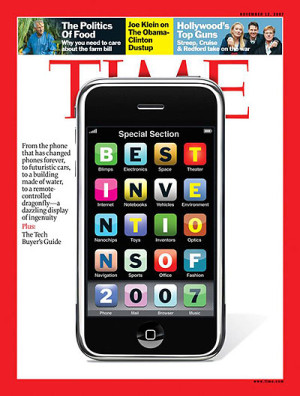
When Steve Jobs introduced the original iPhone in 2007, he answered the question how nearly all mobile computers will look like in the future. Regardless if competitors knew it or not, they only had two alternatives: 1) “slavishly copying the iPhone” or 2) choose ignorance and see their market share entering the free fall. Only three years after entering the mobile phone market, Apple already commanded more than 50% of the global profits.
The original iPhone promised to be “three products in one”- a music player, a mobile phone and a touch Internet terminal. It soon became much more than that. Against Steve Jobs’ desire to control the whole user experience, hackers enabled us to jailbreak our iPhone and install a fast growing number of useful (or at least entertaining) apps. Jailbroken iPhones soon became the better iPhones and Apple quickly changed course.
The following year, Apple launched the App Store and turned the iPhone into a full blown mobile computing platform. They managed to provide what turned out to be an explosive balance between openness and control. Apple still maintained control over the iPhone ecosystem, but now everyone could start writing apps for the iPhone and have Apple distribute them for free or 30% of the sales price for paid apps. It has never been easier to find, install and update software on a computer. Everyone did it. With more than a billion downloads and a default price point for most paid software of 99 cents, the App Store redefined the software business.
Again, the Microsoft board might wonder, why Microsoft didn’t use their monopoly to build a similar software distribution platform for PCs.
The iPhone soon became one of the fastest selling consumer devices in history. Fortunately, Apple didn’t have to start from scratch building a sufficient supply chain. While long lines in front of Apple stores around the world and temporally constrained supplies became the norm for every new launch, Apple always managed to catch up with the demand quickly by further optimizing their supply chain. First, they became more valuable than Microsoft, then they became the most valued public company on Earth.
The strategic value of the iPhone for Apple is gigantic. The market is enormous and still growing with high customer loyalty and a replacement cycle of less than 2 years for Apple’s iPhone. Owning the latest iPhone for many became the ultimate status symbol. Everyone stood in line to lay their hands on the latest model, Apple fan boys, corporate executives, teenagers, and not to forget the growing middle class in China, creating another strong halo effect for other Apple products.
In order to invent the iPhone, Apple had to answer the question how a mobile operating system has to look like. Steve Jobs concluded that a touch device asked for a fundamentally different interaction model than personal computers, and therefore Apple decided to build a new mobile operating system instead of using a downsized MacOS X. This decision to develop iOS turned out to be strategic. According to Steve Jobs, the PC ecosystem was caught in a kind of local optimum. You have to start fresh, ignoring many existing rules and explore completely new solutions to arrive at superior solutions. The resulting operating system iOS is designed for touch interfaces from the inside out. There are no windows anymore, no console, no file manager, and (nearly) no need to stop applications. Software installation is done with a click, automated updates inclusive. iOS devices are always on, ready to go in a second and still achieving a tremendous battery life. iOS achieved many things that PCs didn’t. They came without a manual and were used by toddlers and grandparents alike.
Phase 6: Finally disrupt the incumbent’s business
In 2010, it was time to take the lessons learned with the iPhone and apply them to the world of more traditional computers. Leveraging everything Apple had learned and built with the iPod and iPhone, they first released their own take on tablet computers.
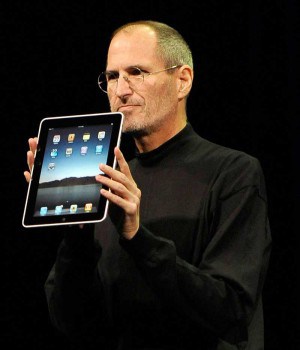
The tablet market was around for a while but still irrelevant. That changed when Steve Jobs introduced the iPad. He believed it was the greatest thing they ever did and felt “annoyed and depressed” when people initially laughed at it. He was right non the less. The iPad sold even more quickly than the iconic iPhone and became thefastest selling consumer device in history. Within two years, many competitors tried and failed to match the iPad’s appeal to users. At the same time, PC makers started to feel its deep impact. PC shipments stalled. Companies, universities and schools started to deploy iPads replacing traditional PCs in troves and it soon became a shared believe that tablet shipments will dwarf PC shipments some day in the not to distant future.
Even without tablets, Apple won market share in the traditional PC market for more than 20 consecutive quarters. But Apple wanted more. Also in 2010, Apple added a second line of attack and started to bring iPhone/iOS innovations back to the Mac nurturing the famous halo effect. With the relaunch of the MacBook Air and MacBook Pro with Retina Display, Apple started to apply lessons learned in the mobile space directly in the PC space, leveraging parts of the same supply chain.
Microsoft finally woke up and now wants to “compete with Apple in every market”. I wouldn’t bet on their success.
Can it be done again?
What I find most fascinating about Steve Jobs’ strategy to turn around Apple is the rigorous long-term thinking in so many dimensions. Many trends that put other companies on defense were leveraged by Apple many years ago. Microsoft and RIM are struggling with the consumerization of IT, Nokia is struggling with touch interfaces, BestBuy is struggling with “showrooming”, the PC ecosystem is struggling with complexity, Android is struggling with fragmentation. Motorola, HTC and LG struggling with commoditization. Apple addressed all these challenges early on. There have certainly been surprises and the need to rewrite parts of the strategy on the go like the decision to open up the iPhone more than planned in the first place. However, the executive team at Apple seemed to have applied long-term thinking to answer many detailed questions regarding their strategy.
In principle, a turnaround like Apple’s can be done again – at least in fields with a high degree of innovation. If there is innovation there will be disruption, and if there is disruption someone can catch the new wave, surf it and overthrow the incumbent. What Apple’s story tells us too, is that incremental improvements won’t be enough if you are losing. You have to identify a need that is not addressed well and be at least ten times better than existing solutions. Ideally, this need is shared by enough people and leads you in a direction you want to go in order to catch the next wave.
“A good hockey player plays where the puck is. A great hockey player plays where the puck is going to be.”
Wayne Gretzky
The two things that played a major role for Apple’s turnaround that won’t be available for most other companies is the ideals Apple stood for and their loyal followers around the world. Even in Apple’s dark times around 1998, Apple was admired by many. Most people wanted Apple to succeed. That makes a difference and you might ask yourself how much this can be said about RIM, Microsoft, Nokia or Yahoo!?
Sören Stamer is a German entrepreneur living in San Francisco, co-founder of Yokudo & CoreMedia, German Fairness Prize 2009 recipient, TEDster and running father.
This article was first published on his Tumblr blog.
You’ll find Sören also on Twitter.


[…] Every iconic brand and every successful hidden champion was able to catch a powerful wave at just the right time. Nike launched its iconic brand by catching the personal fitness wave. Microsoft caught the wave of affordable personal computing. Apple at first caught the personal computing wave and later, during Steve Jobs’ second term, pulled off the greatest comeback in corporate history by catching a giant wave better than anyone else: the mobile computing wave. The story about Apple’s comeback is fascinating in itself: Here is a longer reflection about it I shared back in 2014. […]